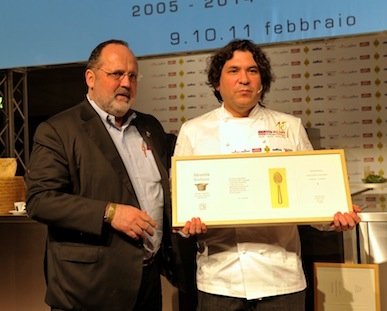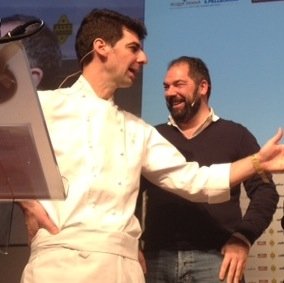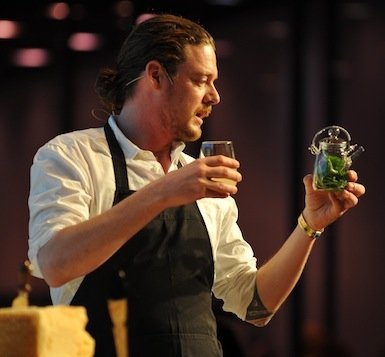42 restaurants in 15 countries: Gaston Acurio is the caudillo of the new Latin cuisine. Healthy, the congress’ theme has been investigated in its economic and social aspects, without abandoning the gastronomic essence. Because the chef is indeed the person who can heal the wound between countryside and town, from which the guerrilla is suppurated. So first of all came the tribute to campesinos and fishermen, something that led to a populist wind blowing over the congress with biodiversity as an aspect of an inextinguishable social-diversity. This was the case with the eclectic quinoa, a notably autochthonous ingredient, representing a crown around an egg yolk with asparagus; or the potatoes dehydrated, following tradition, in pork juices, with fish, cocoa and peanuts, uniting the country on the plate. Third story, third redemption: that of the street chefs, an invisible army whose symbol is ceviche.

Together with Paolo Marchi, Gaston Acurio, a monument in the Peruvian cuisine scene
The Nordic response arrived in the words of
Kobe Desramauts. The young Belgian chef focused his lecture on the <i>à la page</i> theme of fermentation, a process capable of “giving back life to everything”. As kids playing with Chemistry Lab, he has all sorts of liquids bubbling in small vases, and resuscitates strange mushrooms such as the elderberry jelly ear, under the supervision of the University of Antwerp. And again there is the barley fermented with milk, the flax miso, the veal cuttings mixed with koji, the lamb head sawn on stage as a memento of food cruelty.
A point of reference for a whole generation of Italian journalists and chefs,
Fulvio Pierangelini has united two masters who illustrated his primacy on the stage. This tribute was translated into the language of cuisine thanks to a quotation-approach: first the super famous 1985
passatina, invented on a closing day with makeshift ingredients, for two noble customers, and resuscitated by
Massimiliano Alajmo in the shape of “Angelini bread” made with chickpea flour and cut into half and toasted, and then topped with raw prawns and mixed lettuce and incense, as hieratic as the boss’ silences. The second metamorphosis was given by the scallops with mortadella re-invented by
Massimo Bottura with a pasta that simulates a mortadella filled with scallops and wild fennel, plus a little spray of mortadella distillate. “Because ravioli are a secret”, and the soul of a chef lies in this mystery.

Massimiliano and Raffaele Alajmo, Le Calandre in Rubano (Padua)
Following the concept of fluidity, that is to say of a material current pushing cuisine,
Massimiliano Alajmo remained on stage together with his brother
Raffaele. Imagining a return to the motherly womb helped by water, following a work on the nose as a channel for memories. Water, the first component in the human body, with its regenerating capacity is the channel for the metamorphosis of cooking procedures, it transports and characterises the flavours with its vibrations. The saffron risotto with powdered liquorish, in this way, flows like an auto-remake into the risotto: it’s the same but not exactly so. Then there’s the Nudo e crudo (literally naked and raw) meat and fish; the golden stock, a chewable version thanks to the collagen content; the non-closed ravioli as in Umberto Eco’s open text. All the dishes transmit a restless, evolved and informal aesthetic. This is something completely different from the version of <i>Le Calandre</i> we knew. On stage, the monographic apple with meringue, sorbet, gelatine, as fugacious as
Andoni Luis Aduriz’s masterpieces.
Then we’re back, in one blow, to the healthy approach of
Jeremy Bearman and Kristy Del Coro, the former a chef, the latter a nutritionist, who have made a Michelin star shine over
Rouge Tomate. Their concept mixes gourmandise, sustainability and wellness: the main rule is that of the Mediterranean diet, analysed in depth thanks to the study of the synergies between ingredients. An example is given by the roasted carrots with coriander, glazed with honey and orange, with the addition of avocado and pistachios, on a yogurt vinaigrette, so as to recreate a small tree of life. Or the cauliflower cream with pasta.

Kobe Desramaults, creative Flanders
Form and substance are more than just two Aristotelian categories, but they’re also the guidelines followed by Italian cuisine according to
Davide Oldani. Despite varying the appearance, identity has hardly been changed. And it continues to become concrete in the axiology of
Calvino’s American lectures: lightness, rapidity, exactness, multiplicity and visibility. As with the Milanese saffron rice served with a light saffron stock made using the flower, completed with a melting-pot-approach thanks to the rice in crispy pasta. The rooster cooked in bladder also followed the
classique style, an example of low temperature (and indirect) ante litteram cooking, recalling
Fernand Point. Finally there’s
food design: an additional tool for the chef’s intelligence, according to
Oldani.